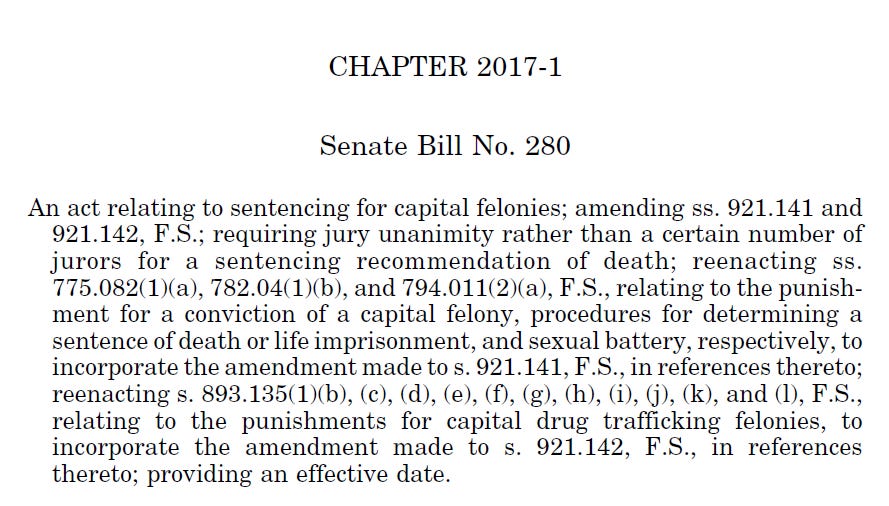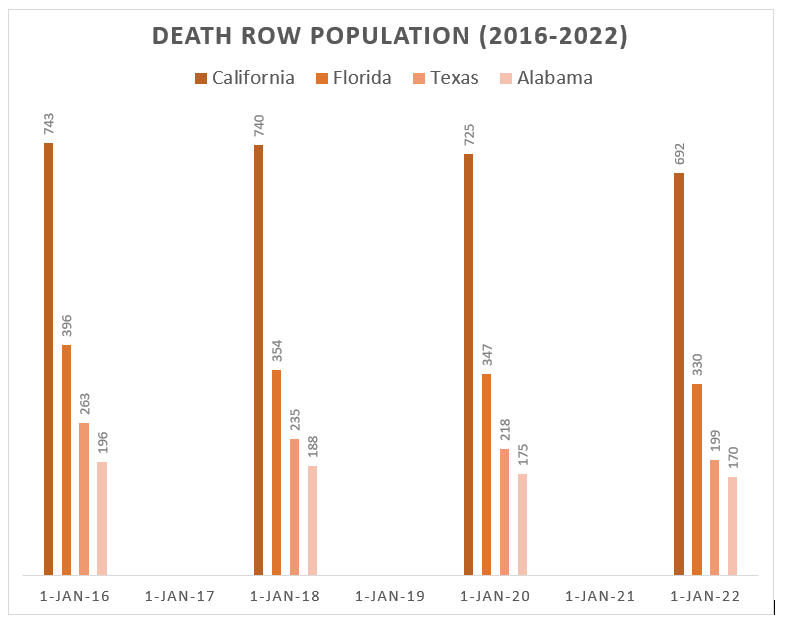What happened in 2016? (Part IV)
This is Part IV of V explaining what happened in 2016 that disrupted Florida's capital sentencing system and led to the currently proposed legislation.
Welcome back. This is Part IV of a five-part series explaining what happened in 2016 that led to Florida’s current capital sentencing scheme and the proposed legislation pending in the Legislature this session.
If you’re just joining, Part I can be found here. Part II can be found here. Part III can be found here.
I said I’d try to keep this series on Friday’s, but there’s just been so much going on. This one is at least closer than Part III.
We left off in Part III with the Supreme Court of Florida’s decisions that created a framework under which the ~400 people on Florida’s death row when Hurst was decided were sorted based on the date their sentence was final and the jury’s vote for death in their case to determine whether they were entitled to relief. One vote or one day made the difference.
New Statute (2017)
As a result of the Florida Supreme Court’s decision in Hurst II, the Legislature passed a new capital sentencing statute that implemented the requirements from the Court’s decisions.
Under the new statute, the jury was required to to find unanimously each of the following:
That the State proved each aggravating factor beyond a reasonable doubt;
That the aggravation is sufficient for a sentence of death;
That the aggravation outweighs the mitigation; and
That death is the appropriate sentence.
NOTE: This wasn’t the Legislature’s first attempt at a post-Hurst capital sentencing statute. As discussed further in Part III, while the Florida Supreme Court’s decision in Hurst II was pending, the Legislature enacted a revised capital sentencing statute that used a 10-2 jury vote threshold (up from the prior 7-5).
Since this statute was passed in 2017, unanimity has been the standard in Florida.
Wave of Litigation
As you can imagine, Hurst caused a wave of litigation.
Almost every person on death row at the time filed a claim for relief based on the decision. Then, those who were denied relief based on the Court’s retroactivity decision in Asay (explained in Part III) filed a second wave of claims seeking relief, which were denied under Hitchcock (also explained in Part III).
Put simply, it was chaos with lives hanging in the balance.
Ultimately, the Hurst litigation resulted in the courts granting approximately ~100 resentencing proceedings, where the defendant would receive a new penalty phase trial under the new statute. Some of those resentencing proceedings are still pending. Several of those who did receive new penalty phases due to Hurst have been resentenced to life. See yesterday’s post for the most recent update from a Hurst resentencing.
Death Row Numbers
Since Hurst, Florida’s death row population has decreased. As of April 4, 2023, there were 299 people on Florida’s death row. Even with this decrease, Florida still has the highest death row population of state’s that continue executions. Of all states, it has the second highest population—second to California. Next in line is Texas, which had 184 people on death row as of March 10, 2023.
The chart below shows the death row populations for the four states with the highest number of people on death row—California, Florida, Texas, and Alabama—for 2016-2022:
Also, the higher jury vote threshold did not cause Florida to drastically decrease the number of death sentences imposed relative to the rest of the country. In 4 of the last 5 years, Florida was responsible for the most death sentences, as explained here:
After unanimity was passed in 2017, Florida led the nation in death sentences for 4 of the next 5 years, tying Texas in 2018 with 7 death sentences and leading the nation in 2019 and 2020 with 7 death sentences imposed each of those years. Because of COVID, there were fewer trials in 2021. That year, Florida sentenced 2 people to death, only 2 fewer than Alabama and Oklahoma. Finally, in 2022, Florida again led the nation with 4 death sentences.





